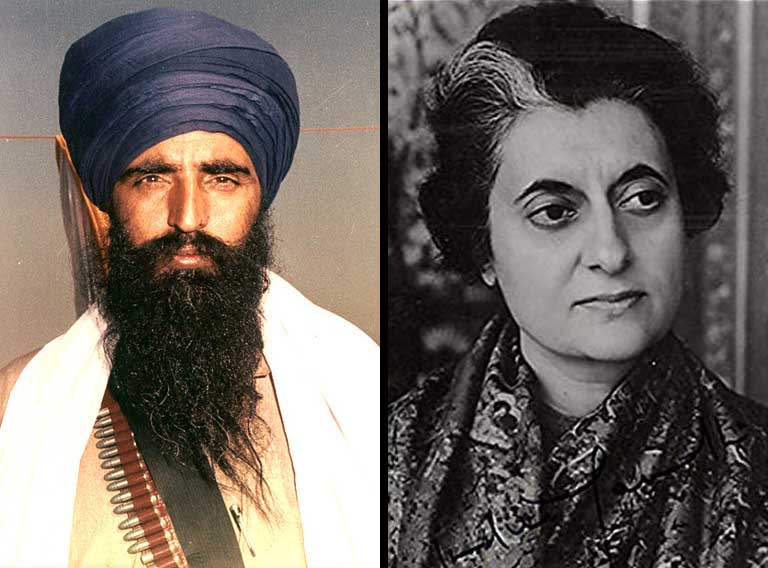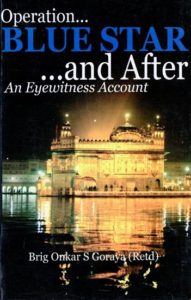June 1984 -Sikhs give death-defying resistance – Die fighting like Tigers
![June 1984 was an intensely war-like assault on Darbar Sahib, with the systematic killing of thousands of lives by the rampaging Indian army. It formed the first of a two-part part genocidal strike on the Panjaabi-Sikhs over 1984. The second strike in November 1984. Part I saw a raging bombardment and destruction of Akal Takht Sahib, the genocide of its people and an attempt to terrorise into submission the people of Panjaab, argues British activist-writer Jagdeesh Singh. IN 1984, THE […]](https://www.theworldsikhnews.com/wp-content/uploads/2020/06/Indian-army-at-darbar-sahib-360x161.jpg)
June 1984 was an intensely war-like assault on Darbar Sahib, with the systematic killing of thousands of lives by the rampaging Indian army. It formed the first of a two-part part genocidal strike on the Panjaabi-Sikhs over 1984. The second strike in November 1984. Part I saw a raging bombardment and destruction of Akal Takht Sahib, the genocide of its people and an attempt to terrorise into submission the people of Panjaab, argues British activist-writer Jagdeesh Singh.
IN 1984, THE INTRINSICALLY BRAVE, EAGER AND REVOLUTIONARY SIKHS had escalated an expanding movement for full autonomy and self-determination. This Sikh-driven, national Panjaabi self-determination movement symbolised peoples’ resistance and peoples’ power against the oversized, overpowering draconian Indian state.
The Indian state, tired and fed up of the sustained Panjaabi-Sikh resistance to its superimposing state power (so oppressively and brutally displayed on partitioned East Panjaab since 1947), took to finally launching its state-orchestrated hate campaign against the ‘separatist’ and ‘terrorist’ threat of the Sikhs, and then the connected hammer blow of a mammoth military onslaught and crackdown on Darbar Sahib and entire Panjaab in June 1984. This was India’s final solution of the burgeoning Panjaabi-Sikh problem.
The Indian state with its dogma of Hindu majoritarian-Indian supremacy, ‘territorial unity and integrity’ and Indianisation and Hinduisation; launched its genocidal military war on defenceless Panjaab, in the attack code-named ‘Operation Bluestar’, with 150,000 Indian army troops and tanks, helicopter gunships and other deadly military hardware. There was total lock-down on Panjaab for an entire month, with all journalists and telecommunication contact, banned and shut down.

Panjaab was turned into one mammoth war zone and concentration camp, with the Indian establishment deciding to deliver its deadly, devastating blow to the aspirational, buoyant Sikhs of Panjaab who were a beacon of freedom, self-determination, radical reform, change and break-up of the concentrated, centralised Indian state power.
Brigadier Onkar Goraya (Retd) who formed part of the India army’s assault, has set out his useful eye-witness version of the military action on Darbar Sahib in his book, Operation Bluestar and After -An Eyewitness Account (2013). In it, he makes many revealing admissions, which do no credit to the Indian Army nor the Indian government. He states in the Preface, that “I am not obliged to mask the unsavoury acts committed by members of the security forces including Army.” He adds that the reason for his 30-year delay in publishing this book was “In the beginning, the army uniform forced me to stay mum.”
The agitating Sikhs were led and energised by the braveheart Bhai Jarnail Singh Bhindranwale (1947-1984), bearing his rustic indigenous Panjaabi simplicity and qualities combined with the impassioned Sikh ethics and impulses. “He was selfless and spoke his mind without fear,” says Brig Onkar Goraya in Operation Bluestar, 2013, page 10).
“The Army did succeed as expected of it, but only through an overkill.”
Saint-Soldier Bhindranwale demonstrated to the frustrated and embittered Indian establishment, made up of its usual core Brahmin-Hindu-Bania personalities; that the Panjaabi nation inspired and infused by the Guru-Sikh spirit were ready to fight on in courageous defiance against the pounding attacks of police intimidation, violence and killings that the Indian state was inflicting on them.
The Indian state, as now fully proven from secret document disclosures, had been planning and preparing to militarily attack Amritsar (the epicentre and symbolic heart-beat of the movement) and its central Panjaab-Sikh national shrine, for over a year in advance. Bhai Jarnail Singh Bhindranwale had come to learn of this surreptitious plan and warned of the dire and devastating consequences of Indian police or military invading Darbar Sahib in his multiple impassioned speeches which echoed across its environs.
When the Indian attack and siege came at the very point of Guru Arjan’s Jee annual Shaheedi-martyrdom gathering, initial, with Indian troops having already been stationed in Amritsar since January 1984 in readiness and there was mass mobilization of Indian army troops at the end of May 1984 into Panjaab. It was no less than a war, a military occupation, and total physical subjugation.
Brigadier Goraya of the Indian Army comments: “The Govt’s decision to seal and isolate the whole of Punjab was not only justified, it was a paramount necessity to avert a general uprising by the Sikh masses all over Punjab.” (Operation Bluestar – An Eyewitness Account, 2013, page 38).Its entire borders were sealed and declaration of full curfew on its people.
The Sikh fighters within Darbar Sahib fought back vigorously against the decrepit Indian troops. It was Indian foot soldiers pitted against solid lions. With their hearts, minds and some weapons, Bhindranwale and his 100 plus fellow combatants, against 15,000 Indian troops, tanks and helicopter gunships; fought from 1st to 7th June 2020 in an intense armed and hand-to-hand battle.
 As cited by Brigadier Onkar Goraya, there is a report of a remaining single Sikh fighter, surviving up to 8th June 1984, who fired upon the arriving Indian President and his entourage as he entered the Harmandir Sahib complex (‘Operation Bluestar and After – An Eyewitness Account’, 2013, page 101)
As cited by Brigadier Onkar Goraya, there is a report of a remaining single Sikh fighter, surviving up to 8th June 1984, who fired upon the arriving Indian President and his entourage as he entered the Harmandir Sahib complex (‘Operation Bluestar and After – An Eyewitness Account’, 2013, page 101)
General Shabeg Singh led and co-ordinated the Sikh resistance, as well as laying down his life in the process with his comrades. “He performed this task with utmost professional skill, says Brigadier Goraya, (Operation Bluestar, 2013, page 21.)
The BBC London filmed Kuldip Brar, the devious Indian general tasked with leading the military assault, on 7th June 1984, as he boasted to the world media that he had wiped out the ‘terrorists’ and ‘militants’. As he began to speak on camera, his words were vividly disrupted by the powerful and pounding firing of surviving Sikh fighters who were displaying their unsubdued final stand. Brar was visibly shaken by this unexpected upsurge.
The indiscriminate, horrific and callous slaughter of thousands of civilian Panjaabi men, women and children, by the Indian troops, amounts to a crime against humanity. Added to this was the burning and looting down of the National Sikh Reference Library as a deliberate action at the behest of the Indian army commanders. It took place on 7th June 1984, following the Indian army’s final destructive tank assault on 6th June 1984 on Akaal Takht Sahib where Jarnail Singh and his last band of fighters were positioned. The burning down of the national library, its treasured content and the removal of thousands of cherished manuscripts and documents which remain wholly withheld by the Indian state to this day.
Having done with Amritsar, India turned to part two of Operation Bluestar, which was a merciless and predatory sweep across 42 other Gurdwaras and through each and every village of East Panjaab, code-named Operation Woodrose. It was no less than a war, a military occupation, and total physical subjugation.
The classic and historical resistance of the brave and committed against the foot soldiers of an oppressive Indian state is unique and history making. It was a display of courage over military hardware. Spirit over numbers. Passion and purpose over cold, calculated military purpose. Not a single one of the Sikh combatants surrendered..
The June 1984 monumental slaughter and destruction and even prior to that, will one day be properly and fully exposed to the world. It stands as one of modern history’s most gruesome unrecognised genocides, committed by a state intent on subduing and crushing a people into submission. It was the first part of India’s final solution of the Panjaab and Sikh question.
The classic and historical resistance of the brave and committed against the foot soldiers of an oppressive Indian state is history-making. It was a display of courage over military hardware. Spirit over numbers. Passion and purpose over cold, calculated military purpose. Not a single one of the Sikh combatants surrendered.
Brigadier Onkar Goraya in his confessional book says, “The Army did succeed as expected of it, but only through an overkill.” (Operation Bluestar -An Eyewitness Account, Brigadier Onkar Goraya, 2013, page 2).
The days of 1-7 June 1984 are gloriously enshrined in the hearts of millions of proud Panjaabis inside and across the world. Glorious history was made as a mighty alien army came to kill, destroy and subdue. As the simple, hardy people of Panjaab, inspired by their Gurus, heroes and enduring spirit fought back.
Jarnail Singh Bhindranwale and his few hundred comrades within the sacred bastion of the sovereign and independent spirit of Panjaab fought like tigers, conscious of their role and eagerly waiting for the moment of glorious death. Their martyrdom continues to inspire us to continue the struggle.
 Print
Print

 320
320

